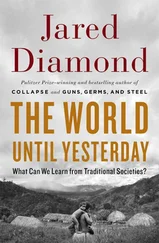Jared Diamond - Guns, Germs & Steel
Здесь есть возможность читать онлайн «Jared Diamond - Guns, Germs & Steel» весь текст электронной книги совершенно бесплатно (целиком полную версию без сокращений). В некоторых случаях можно слушать аудио, скачать через торрент в формате fb2 и присутствует краткое содержание. Жанр: 105. Описание произведения, (предисловие) а так же отзывы посетителей доступны на портале библиотеки ЛибКат.
- Название:Guns, Germs & Steel
- Автор:
- Жанр:
- Год:неизвестен
- ISBN:нет данных
- Рейтинг книги:5 / 5. Голосов: 1
-
Избранное:Добавить в избранное
- Отзывы:
-
Ваша оценка:
- 100
- 1
- 2
- 3
- 4
- 5
Guns, Germs & Steel: краткое содержание, описание и аннотация
Предлагаем к чтению аннотацию, описание, краткое содержание или предисловие (зависит от того, что написал сам автор книги «Guns, Germs & Steel»). Если вы не нашли необходимую информацию о книге — напишите в комментариях, мы постараемся отыскать её.
Guns, Germs & Steel — читать онлайн бесплатно полную книгу (весь текст) целиком
Ниже представлен текст книги, разбитый по страницам. Система сохранения места последней прочитанной страницы, позволяет с удобством читать онлайн бесплатно книгу «Guns, Germs & Steel», без необходимости каждый раз заново искать на чём Вы остановились. Поставьте закладку, и сможете в любой момент перейти на страницу, на которой закончили чтение.
Интервал:
Закладка:
HISTORY'S haves and have-nots * 9 5
animal remains at archaeological sites. Most domesticated plant and animal species differ morphologically from their wild ancestors: for example, in the smaller size of domestic cattle and sheep, the larger size of domestic chickens and apples, the thinner and smoother seed coats of domestic peas, and the corkscrew-twisted rather than scimitar-shaped horns of domestic goats. Hence remains of domesticated plants and animals at a dated archaeological site can be recognized and provide strong evidence of food production at that place and time, whereas finding the remains only of wild species at a site fails to provide evidence of food production and is compatible with hunting-gathering. Naturally, food producers, especially early ones, continued to gather some wild plants and hunt wild animals, so the food remains at their sites often include wild species as well as domesticated ones.
Archaeologists date food production by radiocarbon dating of carbon-containing materials at the site. This method is based on the slow decay of radioactive carbon 14, a very minor component of carbon, the ubiquitous building block of life, into the nonradioactive isotope nitrogen 14. Carbon 14 is continually being generated in the atmosphere by cosmic rays. Plants take up atmospheric carbon, which has a known and approximately constant ratio of carbon 14 to the prevalent isotope carbon 12 (a ratio of about one to a million). That plant carbon goes on to form the body of the herbivorous animals that eat the plants, and of the carnivorous animals that eat those herbivorous animals. Once the plant or animal dies, though, half of its carbon 14 content decays into carbon 12 every 5,700 years, until after about 40,000 years the carbon 14 content is very low and difficult to measure or to distinguish from contamination with small amounts of modern materials containing carbon 14. Hence the age of material from an archaeological site can be calculated from the material's carbon 14/carbon 12 ratio.
Radiocarbon is plagued by numerous technical problems, of which two deserve mention here. One is that radiocarbon dating until the 1980s required relatively large amounts of carbon (a few grams), much more than the amount in small seeds or bones. Hence scientists instead often had to resort to dating material recovered nearby at the same site and believed to be "associated with" the food remains—that is, to have been deposited simultaneously by the people who left the food. A typical choice of "associated" material is charcoal from fires.
But archaeological sites are not always neatly sealed time capsules of
96 • GUNS, GERMS,and steel
materials all deposited on the same day. Materials deposited at different times can get mixed together, as worms and rodents and other agents churn up the ground. Charcoal residues from a fire can thereby end up close to the remains of a plant or animal that died and was eaten thousands of years earlier or later. Increasingly today, archaeologists are circumventing this problem by a new technique termed accelerator mass spec-trometry, which permits radiocarbon dating of tiny samples and thus lets one directly date a single small seed, small bone, or other food residue. In some cases big differences have been found between recent radiocarbon dates based on the direct new methods (which have their own problems) and those based on the indirect older ones. Among the resulting controversies remaining unresolved, perhaps the most important for the purposes of this book concerns the date when food production originated in the Amer-icas: indirect methods of the 1960s and 1970s yielded dates as early as 7000 b.c., but more recent direct dating has been yielding dates no earlier than 3500 b.c.
A second problem in radiocarbon dating is that the carbon 14/carbon 12 ratio of the atmosphere is in fact not rigidly constant but fluctuates slightly with time, so calculations of radiocarbon dates based on the assumption of a constant ratio are subject to small systematic errors. The magnitude of this error for each past date can in principle be determined with the help of long-lived trees laying down annual growth rings, since the rings can be counted up to obtain an absolute calendar date in the past for each ring, and a carbon sample of wood dated in this manner can then be analyzed for its carbon 14 / carbon 12 ratio. In this way, measured radiocarbon dates can be "calibrated" to take account of fluctuations in the atmospheric carbon ratio. The effect of this correction is that, for materials with apparent (that is, uncalibrated) dates between about 1000 and 6000 b.c., the true (calibrated) date is between a few centuries and a thousand years earlier. Somewhat older samples have more recently begun to be calibrated by an alternative method based on another radioactive decay process and yielding the conclusion that samples apparently dating to about 9000 b.c. actually date to around 11,000 b.c.
Archaeologists often distinguish calibrated from uncalibrated dates by writing the former in upper-case letters and the latter in lower-case letters (for example, 3000 b.c. vs. 3000 b.c., respectively). However, the archaeological literature can be confusing in this respect, because many books and papers report xncalibrated dates as b.c. and fail to mention that they are
HISTORY'S HAVES ANDhave-nots • 97
actually uncalibrated. The dates that I report in this book for events within the last 15,000 years are calibrated dates. That accounts for some of the discrepancies that readers may note between this book's dates and those quoted in some standard reference books on early food production.
Once one has recognized and dated ancient remains of domestic plants or animals, how does one decide whether the plant or animal was actually domesticated in the vicinity of that site itself, rather than domesticated elsewhere and then spread to the site? One method is to examine a map of the geographic distribution of the crop's or animal's wild ancestor, and to reason that domestication must have taken place in the area where the wild ancestor occurs. For example, chickpeas are widely grown by traditional farmers from the Mediterranean and Ethiopia east to India, with the latter country accounting for 80 percent of the world's chickpea production today. One might therefore have been deceived into supposing that chickpeas were domesticated in India. But it turns out that ancestral wild chickpeas occur only in southeastern Turkey. The interpretation that chickpeas were actually domesticated there is supported by the fact that the oldest finds of possibly domesticated chickpeas in Neolithic archaeological sites come from southeastern Turkey and nearby northern Syria that date to around 8000 b.c.; not until over 5,000 years later does archaeological evidence of chickpeas appear on the Indian subcontinent.
A second method for identifying a crop's or animal's site of domestication is to plot on a map the dates of the domesticated form's first appearance at each locality. The site where it appeared earliest may be its site of initial domestication—especially if the wild ancestor also occurred there, and if the dates of first appearance at other sites become progressively earlier with increasing distance from the putative site of initial domestication, suggesting spread to those other sites. For instance, the earliest known cultivated emmer wheat comes from the Fertile Crescent around 8500 b.c. Soon thereafter, the crop appears progressively farther west, reaching Greece around 6500 B.C. and Germany around 5000 b.c. Those dates suggest domestication of emmer wheat in the Fertile Crescent, a conclusion supported by the fact that ancestral wild emmer wheat is confined to the area extending from Israel to western Iran and Turkey.
However, as we shall see, complications arise in many cases where the same plant or animal was domesticated independently at several different sites. Such cases can often be detected by analyzing the resulting morphological, genetic, or chromosomal differences between specimens of the
Интервал:
Закладка:
Похожие книги на «Guns, Germs & Steel»
Представляем Вашему вниманию похожие книги на «Guns, Germs & Steel» списком для выбора. Мы отобрали схожую по названию и смыслу литературу в надежде предоставить читателям больше вариантов отыскать новые, интересные, ещё непрочитанные произведения.
Обсуждение, отзывы о книге «Guns, Germs & Steel» и просто собственные мнения читателей. Оставьте ваши комментарии, напишите, что Вы думаете о произведении, его смысле или главных героях. Укажите что конкретно понравилось, а что нет, и почему Вы так считаете.










